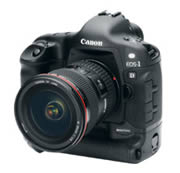Canon EOS-1D Digital SLR Camera
Canon Updated: 2007-07-23It's not just performance, it's total performance. The EOS-1D.
If you need speed, look no further: capable of 8 frames per second, for up to 21 consecutive shots, the EOS-1D is one of Canon's fastest digital SLR cameras. The EOS-1D has a 4.1 MP CCD (1.3x conversion factor) for high-performance imaging, manual settings for color space, white balance and tone curves, seamless compatibility with Canon's range of lenses and Speedlites, entirely new driver software for the PC and Mac with powerful new tools for image control and camera customization, and a host of other custom features. A magnesium alloy body and chassis, extensive moisture and dust resistance, combined with the handling and build quality of the EOS-1v make the EOS-1D a sports and action photographer's dream come true.
Features
- Performance
- Build & Reliability
- Image Quality
- Software
Raising the bar again. Canon redefines total performance. Many factors go into making this professional performance possible. Significant advances in large-volume data processing technology, a completely new imaging engine, and advancements in mirror speed technology learned during development of the 35mm EOS-1v all contribute to the EOS-1D's speed and responsiveness.
8 fps - the fastest continuous shooting speed of any digital SLR camera. Until you experience the EOS-1D's total performance in your hands, its specs are just numbers. It's when you pick it up and feel its responsiveness…feel - but not hear it run through 21 consecutive frames 60% faster than any other competitive professional digital SLR* that you know you're in the presence of something truly special.
The world's fastest AF system, covering the world's largest AF area. Forty-five AF points cover more of the picture area than any other digital SLR in the world, making focusing and composing of off-center subjects a one-step operation. It's a versatile system, allowing the photographer numerous methods to manually select an AF point, or allowing the EOS-1D to automatically select the AF point instead.
1/16,000-second shutter speed and 1/500-second X-sync. Imagine the possibilities. The new large-area, four million pixel CCD imaging sensor electronically times shutter speeds, and makes possible speeds as fast as 1/16,000th of a second. EX-series EOS Speedlites can sync to an amazing 1/500th of a second. The bladed rotary-magnet shutter is durability-tested to 150,000 exposures.
Shutter release time lag of just 55 ms. No digital SLR responds faster. A highly responsive viewfinder, courtesy of Canon's original Active Mirror Control method. One of the key hurdles to faster shooting speeds is an SLR was speed the mirror could move up and down, while stopping long enough between frames for an AF system to get updated information. Blackout time between exposures is a barely perceptible 45 ms, and contributes to the sense of solid responsiveness you get using the EOS-1D.
IEEE1394 interface: the ideal way to move large files quickly. Direct-connection to compatible Windows or Macintosh computers is via an IEEE1394 ("FireWire™") interface, giving you the best of both worlds - convenience and speed. IEEE1394 provides reliable plug-and-play operation, and is ideal for fast downloading of EOS-1D image files to the computer.
With a generous buffer memory, the EOS-1D can fire up to 21 consecutive frames (at up to 8 fps) in its full-resolution, best-quality JPEG mode. That's at four million pixels per image. Even more impressively, if capturing both RAW and JPEG images simultaneously, you can still fire bursts of up to 16 frames (at full resolution, of course) at up to 8 fps. A viewfinder indication is updated instantly to advise you of remaining frames in a burst.
The best of both worlds: Image quality and performance. Using the 4.15 million pixel interline-transfer CCD makes true continuous 8 fps operation possible. Also, it functions as its own shutter - interline transfer CCDs can be "turned on" and "turned off" electronically with incredible precision. This is how the EOS-1D is able to shoot at shutter speeds up to 1/16,000th of a second, and perhaps even more important to professionals, sync with flash up to 1/500th of a second.
EOS-1D Instructions
Software Instructions EOS DIGITAL SOLUTION DISK Ver.3 for Windows
Software Instructions EOS DIGITAL SOLUTION DISK Ver.3 for Macintosh
Related Manuals
Canon EOS-1D Mark II Digital SLR Camera
Canon EOS Digital Rebel Digital SLR Camera
Canon EOS 20D Digital SLR Camera
Canon EOS D60 Digital SLR Camera
Canon EOS D30 Digital SLR Camera
Canon EOS-1Ds Digital SLR Camera
Canon EOS ELAN 7/7E 35mm SLR Camera
Canon EOS 10D Digital SLR Camera
Canon EOS Rebel 2000 35mm SLR Camera
Canon EOS Rebel G 35mm SLR Camera
Canon EOS Rebel GII 35mm SLR Camera
Canon EOS Rebel Ti 35mm SLR Camera
